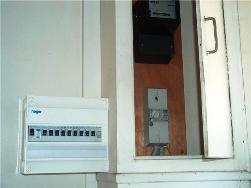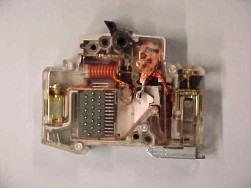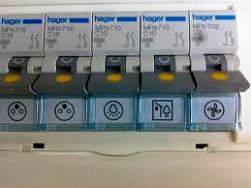Categories: Sharing experience, Electrician at home, Automata and RCD
Number of views: 183,924
Comments on the article: 7
Automata, difavtomats and ouzo, problems of choice
 Classification and practical experience of electrical wiring protection systems
Classification and practical experience of electrical wiring protection systems
Automatic machines or circuit breakers, this is what replaced the usual traffic jams, i.e. fuses in a ceramic case, where a blown wire was a protection against overcurrent.
Unlike plugs, automatic reusable devices and protection functions are separate. Firstly, protection against overcurrents (short circuit currents or short-circuit currents), and secondly, overload protection, i.e. the mechanism of the machine breaks the load circuit with a slight excess of the operating current of the machine.
In accordance with these functions, the machine contains two types of circuit breakers. Magnetic fast-acting circuit breaker for protection against short circuit with an arc extinguishing system (millisecond reaction time) and a slow thermal disconnect with a bimetal plate. Its reaction time is from several seconds to several minutes, depending on the load current.
Automata classification
 There are several typical characteristics of automatic shutdown: A, B, C, D, E, K, L, Z. A – for opening long circuits and for protecting electronic devices. B - for lighting networks; C - for lighting networks and electrical installations with moderate currents (overload capacities in current are twice as much as in V); D - for circuits with inductive load and electric motors; K - for inductive loads; Z - for electronic devices.
There are several typical characteristics of automatic shutdown: A, B, C, D, E, K, L, Z. A – for opening long circuits and for protecting electronic devices. B - for lighting networks; C - for lighting networks and electrical installations with moderate currents (overload capacities in current are twice as much as in V); D - for circuits with inductive load and electric motors; K - for inductive loads; Z - for electronic devices.
RCD classification
Residual current devices RCD protects people from electric shock. The RCD responds to a differential current, i.e. the difference between the currents in the forward and reverse wires. Differential current appears when a person touches a protected circuit and a grounded object. RCDs to protect people are selected for a current of 10-30 mA, fire RCDs for a current of 300 mA protect the entire wiring system, because in a fire, leakage currents usually occur earlier than short-circuit currents.
The choice of an RCD is difficult because it is a more complex device than an automatic machine. For example, there are difavtomats - devices combining an automatic machine and an RCD. RCDs are also divided by type of execution on electronic and electromechanical. Experience has shown that it is better to use electromechanical RCDs. They are better protected against false alarms and breakdowns.
According to the number of poles, RCDs are divided into two-pole, for 220V circuits and four pole, for 380 V.
According to the operating conditions on:
- AC-reacting only to alternating sinusoidal differential current;
- A - reacting both to an alternating sinusoidal differential current and to a constant pulsating differential current;
- B - reacting to an alternating sinusoidal differential current, to a constant pulsating differential current and to a constant differential current.
By the presence of a delay, on an RCD without a delay in general use, and with a time delay of type S. According to the current characteristic (difavtomaty), on B, C, D. And finally, on the rated current. You should be aware that if a conventional RCD and the machine are in series in the same circuit, the machine must be at a lower current than the RCD. Otherwise, the RCD may be damaged, as the machine breaks the load circuit with a delay.
It is important not only to choose the right one, but also to connect an RCD without errors: RCD connection diagram
Experience in the practical use of electrical protection devices
 In conclusion, it must be said that devices of well-known companies should be chosen.
In conclusion, it must be said that devices of well-known companies should be chosen.
For example, ABB, GE POWER, SIEMENS, LEGRAND and others, at least certified in Russia. It is better to choose an electromechanical RCD, as they are much more reliable than electronic ones. Instead of a tandem from an RCD and an automatic machine, it is better to choose a difavtomat, this will make the design of the shield more compact and reliable.
The current characteristics must be selected depending on the wiring used. The operating current of automatic machines and diflavtomats must be less than the maximum permissible cable currents.
For copper three-wire cables, the following table of correspondence of the cross-section of cable conductors in square millimeters and currents of machines can be given: 3x1.5-16; 3x2.5-25; 3x4 - 32; 3x6 - 40; 3x10 - 50; 3x16 - 63.
I hope that after reading all the material it will be easier for you to understand the design and construction of electrical wiring.
See also at e.imadeself.com
:
